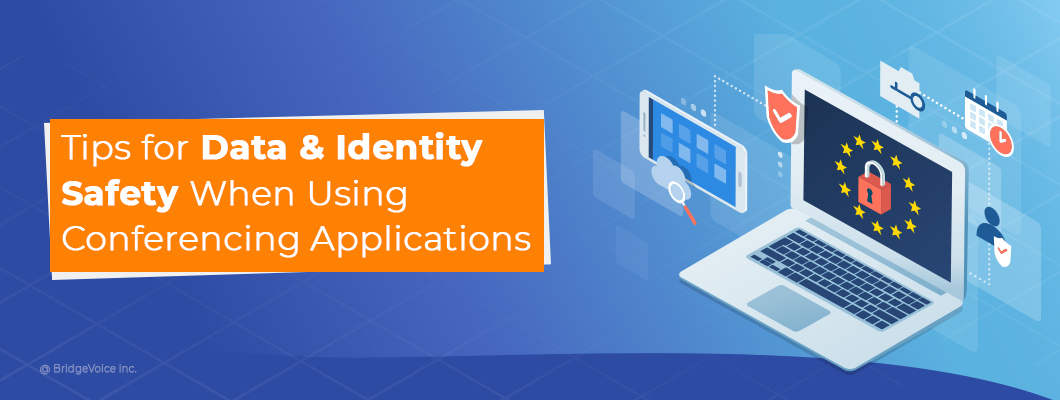Tips for Data and Identity Safety When Using Conferencing Applications

Communications have gone digital since the businesses have gone global; however, they have gained increased prominence since the advent of the COVID-19 pandemic. From home-schooling, work from home to connecting with family and friends, unified communications and DID services have become an important part of daily lives. In April 2020, the popular communication application Zoom announced 300 million daily meeting participants on its platform, up from 10 million daily in December 2019 — a thirtyfold increase in just four months! The pandemic led Zoom to become the top downloaded application in the past year.
While we are utilizing conferencing services from prominent calling applications, we have also experienced or heard of instances where strangers joined an online class or an office meeting. These incidents have resulted in trauma for young children or disturbances during official calls. The US government too focused on the rising trend of remote working as it involves concerns looming over data theft. The National Security Agency also released an assessment of 13 of the most popular video-chatting tools. Some of the grading criteria were:
- Is the service secured with end-to-end encryption, safeguarding the data from potential hackers?
- Does it employ multi-factor authentication, thereby limiting the data access for user accounts?
- Does the application use an open-source code that is more secured rather than an inscrutable proprietary software?
- Does this application share the data with third parties thereby increasing the chances of account details being compromised?
- Is it possible for the user to securely delete data from the application on both client and server-side?
The big question is how can you keep yourself safe while not letting your work be affected? Here are some tips on securing your data and identity:
How to Keep Your Communication Safe?
Use Passwords and Authentication
Use multi-factor authentications preferably, use strong combination passwords, making it harder for hackers to access the devices or online accounts.
Lock Screen Sharing
All participants in the call should not have screen sharing rights and they should be restricted to the host.
Keep a Track of your Settings
Not all security settings are enabled by default, in fact, few settings are different for the desktop and mobile versions of the same application. The desktop settings are more detailed and offer more control than the mobile version.
Keep your Calling App Updated
Most applications keep track of their security vulnerabilities and release updates that include bug fixes and security patches to fix issues and vulnerabilities.
Be Careful when Sharing the Invitation Links
In case of a smaller number of meeting participants, do not publish the meeting links on social media posts, group emails, online profiles, or such public platforms. Use the conferencing software itself to invite the attendees.
Use Firewall to protect the Conferencing Application
Firewalls provide protection against any cyber attackers by shielding the device or network from malicious or unnecessary network traffic. Firewalls can also prevent malicious software from accessing a computer or network via the internet.
Use Webcast instead of Video Conferences for Large Calls
A webcast is conducted online where the participants can watch the presentation and send questions to the speaker. Only selected hosts or presenters should have control of the meeting and therefore it can be managed more efficiently and securely.
Take Extra Caution when using a Public Wi-Fi
The same features that make free Wi-Fi hotspots desirable for consumers make them desirable for hackers; namely, that it requires no authentication to establish a network connection. This creates an opportunity for the hacker to get unfettered access to unsecured devices on the same network. Take precautions while using them.
Caution must be followed along with the benefits that technology brings with itself. When using a conferencing service to connect with your work or family, make sure your digital identity and data are secured. BridgeVoice Pluto is one such secured solution for communication across the world. The service is particularly popular amongst enterprises that strive for secured and seamless communications within their organization. The platform offers extension and department management, incoming DID management, voicemail services, and advanced caller ID settings. When sharing confidential details or simply communicating, never risk your data or your device, trust only the experts.
Manasi Mulasi
Manasi is a content creator and developer at BridgeVoice Inc. A post graduate in Journalism, she has dabbled in various domains in last 10 years of her career. This includes celebrity interviewing, advertising, radio stints and project management. When she is not working, Manasi enjoys a cup of coffee, a Friends rerun and karaoke.

 Fostering Authentic Connections: The Power of P2P SMS-Enabled Numbers and DID Services in Customer Engagement
Fostering Authentic Connections: The Power of P2P SMS-Enabled Numbers and DID Services in Customer Engagement